A great way to save money is to not spend it – contrary to the usual advertising mantra. And a great way to not have to spend money is by doing everything possible to extend the service life of your vehicle and its systems.
One of those systems is the hydraulic system.
Some vehicles – those with manual transmissions – have two of these. Most people have heard of the hydraulic system – for the brake system. If your car has a manual transmission, it has another one – for the clutch system. Both use the same hydraulic fluid. Brake fluid. It is contained in a fluid reservoir – the master cylinder – and routed through the hydraulic lines whenever you push down on the brake (or clutch) pedal. This hydraulic pressure reduces the effort necessary to apply the brakes and operate the clutch.
This system – this fluid – is probably among the most taken-for-granted automotive fluids. Which probably explains why it’s often not changed. Especially as regards the fluid in the clutch circuit, which many people aren’t even aware is there. Until the day the clutch pedal no longer operates the clutch. At which point they are made aware of having to pay for a new clutch master/slave cylinder.
As opposed to paying much less for fresh fluid.
Brake fluid is regularly neglected, too. If it is left unchanged for too long, the potential for master cylinder problems, brake line problems, ABS pump problems and brake caliper problems – all of them a great deal more expensive than a $10 bottle of fresh brake fluid – goes up.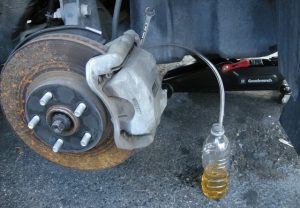
The fluid in both systems is replaced by bleeding the system. This involves opening a bleed valve – there is one at each wheel for the brake system; usually just one for the clutch system – and using the brake/clutch pedal to force out the old fluid while topping off the reservoir (master cylinder) with fresh fluid, being careful to not let any air into the system. Air, unlike fluid, being compressible – leading to a squishy-feeling pedal if air does get into the system.
It is not a difficult do-it-yourself job and it is not an expensive have-someone-else-do-it-for-you job.
But it can get very expensive if you forget to do it – or have it done.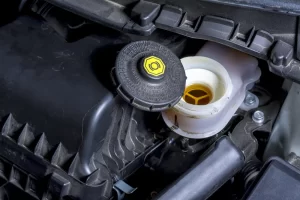
Left unchanged for too long – a sound rule-of-thumb defining “too long” is more than 40,000 miles or three years, whichever comes first) the fluid is apt to turn from almost clear to brown – and (eventually) black. The color change being a visible measure of its degradation – and contamination. The longer you don’t change it, the more likely it is that expensive parts – like the master cylinder, ABS pump, slave cylinder (for vehicles with manuals) brake caliper pistons – and so on – will cost you a lot more money than the cost of a $10 bottle of fresh fluid, or paying someone else to instill it.
Keep on eye on that fluid. That is something anyone can do. The only skill needed being the ability to open the hood and . . . look. The brake master cylinder is usually on the driver’s side, close to the firewall. It is usually see-through (or has an “eye” you can eyeball) to have a look at what’s inside. The clutch fluid master cylinder typically looks similar, just smaller. 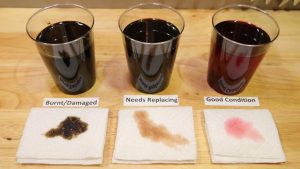
There is also a lid that anyone who can open a jar can open. Have a look. If the fluid is darker than maple syrup it probably needs to be changed. The sooner the better – if you’d rather not open your wallet, wider.
Another hydraulic fluid that’s often taken for granted is automatic transmission fluid – and this taking-for-granted is often a function of the marketing deception that the fluid is good for a “lifetime.”
By which is meant the lifetime . . . of the warranty.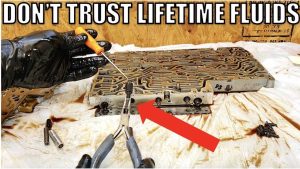
If you’d like your automatic transmission to last a lifetime – meaning, as long as the car does – it is sound policy to replace the fluid (and the filter) once every 50,000 miles or so. Or have it replaced, if you’d rather not replace it yourself. It will save you a great deal more than what you’d spend on a new/replacement transmission.
Anyone can check the fluid themselves – condition and level – and there’s no cost involved. On the other hand, failing to check (once every couple of months) can lead to massive costs, if a slight leak (as from a leaky gasket) goes undetected and the fluid level drops. Letting it get too low can quickly destroy an automatic transmission. Chemically degraded/contaminated fluid will do the same, just not as suddenly.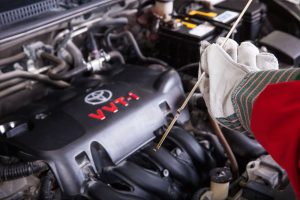
Until all-of-a-sudden.
The fluid can be checked by raising the hood – and finding the dipstick (your owner’s manual will tell you where to look) and looking at it. Make sure the level is where it ought to be (again, see the owner’s manual if the dipstick isn’t clearly marked) and that the fluid isn’t browning. It ought to be red (usually) but never brown. If it is, it’s time to change it. And even if the fluid isn’t browning, if it’s been in there for more than 50,000 miles, changing it is still a good idea because the filter inside the transmission probably needs to be changed by then.
Unless you’d rather it not filter. 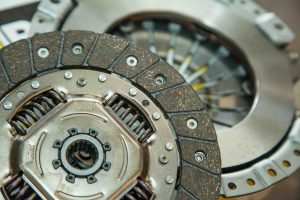
Another thing you can do – to extend the life of a manual transmission (in addition to also changing its fluid) is to gently let the clutch out – transmission in neutral – and let the engine idle for about 10 seconds before you drive off first thing in the morning. This will engage the transmission without loading it and circulate the fluid (lube) within the transmission.
If you want to maximize clutch life, try to keep the vehicle moving – even if it’s just a crawl. Most clutch wear occurs when getting going from a complete stop. If you’re rolling just a little when you let the clutch out, it will wear less – and so last longer. Avoid abrupt shifts – and too much slip. Properly treated, the clutch your vehicle came with can and should last 150,000 miles or even longer.
Much depends on how you drive – and how much you’d like to not have to spend.
. . .
Got a question about cars, Libertarian politics – or anything else? Click on the “ask Eric” link and send ’em in! Or email me at [email protected] if the @!** “ask Eric” button doesn’t work!
If you like what you’ve found here please consider supporting EPautos.
We depend on you to keep the wheels turning!
Our donate button is here.
If you prefer not to use PayPal, our mailing address is:
EPautos
721 Hummingbird Lane SE
Copper Hill, VA 24079
PS: Get an EPautos magnet or sticker or coaster in return for a $20 or more one-time donation or a $10 or more monthly recurring donation. (Please be sure to tell us you want a magnet or sticker or coaster – and also, provide an address, so we know where to mail the thing!)
My eBook about car buying (new and used) is also available for your favorite price – free! Click here. If that fails, email me at [email protected] and I will send you a copy directly!











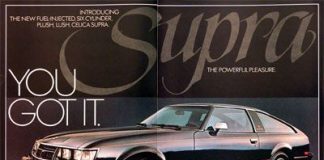
Automatics have been made for about the past 15-20 years as SEALED units…not only can’t you check the fluid, you’re not even supposed to touch them for the first 100K miles. I ran into that about ten years ago when my 2007 Chrysler Pacifica reached 60K miles, and I checked with a local transmission shop to do the fluid and filter change routine, and they not only wouldn’t do it, but advised to leave it alone.
In general, on those automatics with a dipstick, you should have to check it every oil change as long as you’re diligent about keeping it clear and checking for leaks. Putting a piece of cardboard underneath in the garage is a good way to find them. Else, no reason to lose transmission fluid. But I agree about changing automatic fluid and filter every five years or 60K miles, and at least that often, if not more so, for brake and/or clutch fluid.
Yeah: I used to siphon off brake fluid at the master cylinder at every oil change. But now, not anymore. The brake fluid does not *circulate*, it just sloshes back and forth. So, the proper procedure is to take a little off from the caliper, via the bleed valve, like Eric says. So now, every time I have a wheel off, then I will bleed a little out.
I’ve been driving stick for nearly a decade now (learned in ’11-12, but owned my first manual in ’13), and I never once heard about the 10 second clutch trick until now
Who needs skool to learn something important?
Good reminder as fall is a great time to change fluids before winter makes those old fluids thicken up and don’t forget to rust proof your car if they salt the roads where you live.
When I was a boy on the farm, the boss’s car was making funny noises, so I checked the engine oil, and all I got was some sludge on the end of the dipstick. I told him my findings and he yelled “Pinhead, add a quart of oil and get back on that haywagon”.
Later in life a guy told me his Toyota 4Runner quit driving from California to Idaho. The mechanic told him he had no oil in his automatic transmission. He told me he never checked it, he didn’t even know it had oil. The mechanic added oil and it worked normal. That gave me a very positive opinion of Toyota quality.
I think some new Toyotas have sealed transmissions, no dipstick. I think the engineers figured it would be better to build trannies that don’t require checking by pinheads.
I’ve got a ’12 LR4, no dip stick for engine or automatic transmission. For the transmission, look for leaks, change per Land Rover schedule (10 years/150k miles). Engine oil has a sending unit, which has started leaking recently – not too bad to fix at least ($40 part held on with three screws on the bottom of the oil pan).
Thanks, Eric!
Excellent advice article, Eric. Newbies need it, and sometimes old hands can use a reminder or an update.
Since a lot of people own Hondas with automatic transmissions, I’ll share my little story. In 2018, I bought a 2004 Honda Element with automatic tranny and all-wheel drive. It came with no maintenance records. Ugh! So, I had to proceed as if necessary maintenance was not done. IF, I say IF, the transmission never had the fluid changed, then it can possibly cause a problem to totally, in one shot, replace very old dirty fluid with new fluid. So, for three regular engine-oil changes in a row (at 3,000 to 5,000 mile intervals) I had the tranny simply drained (not force-flushed) and refilled, which took 3.3 quarts each time. Yes, it means that the new fluid in the tranny is mixed with old fluid. But it is an easy, safe, cheap, and effective procedure.
I sympathize with people who have the newer vehicles with transmissions that have no dipstick and no simple drain plug. The fluid still needs to be changed (as Eric has pointed out) or strategically diluted, as I have described. But with such newer transmissions, it’s a pain, and a shame.
By the way, since 2015, I have lived in apartment buildings where anything more than changing the air filter is not allowed. So, I found friendly independent repair shops to do what needed to be done.
JL,
I used my parents’ or my brother’s garage for a lot of years, now I use my own garage.
Ah, but on my Mazda 3, it is very, very difficult to check the fluid. The tiny dipstick is bolted down, and you have to remove the air cleaner box to even get to it! Gonna be doing a drain/fill with new fluid 3 times to get most of the old fluid out.
[In boyish Lou Costello voice] I’m a bad boy, Eric.
I’ve always neglected brake fluid- never ever changed it on any vehicle I’ve owned. I may just start doing it. [Though I’ve thus far not had any problems…why tempt fate?].
Thanks for the reminder!
I think ZF8 recommended interval is 70 or 80k now. That’s probably one of the few real examples of technological progress in standard auto technology. It’s pretty reliable and fairly ubiquitous; not sure how well made the FCA assembled ones are.
Make sure and use the correct fluids! Even as cheap as I am, if in doubt I go get the factory stuff. I did the coolant change for the daughters Acura last month and gave up finding an alternative to the Honda/Acura coolant. Not worth the risk of a sludged cooling system or eating up gaskets.
Brake fluid change may require a cycling of the ABS to move old fluid out and new fluid in. My 2018 Harley requires this and I end up at the dealer every two years since it requires their computer hookup to cycle the ABS module. Brake fluid eats paint clean it immediately if you spill!
Surprised how many don’t bother to even read the routine maintenance section in their owner’s manual.
All machines need preventive maintenance. Good reminder.
And to all you with a ZF sealed transmission with lifetime fluid. 60k is lifetime, not 100k or your lifetime.